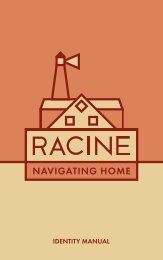Artful Magazine
Artful is about the subtle art, creativity and expression in daily life—the art in you, your environment, to your community. Student Work | Magazine Layout
Artful is about the subtle art, creativity and expression in daily life—the art in you, your environment, to your community.
Student Work | Magazine Layout
You also want an ePaper? Increase the reach of your titles
YUMPU automatically turns print PDFs into web optimized ePapers that Google loves.
Above: Confetti
pieces lay on
the floor of an
apartment in
Madison.
Right: Shields poses
for a photo in her
apartment.
is the product of the Romantic movement, according to
which the expression of feelings constitutes the creation
of art, just as philosophy and other disciplines are the
expression of ideas. It is, at any rate, the theory of art as
the expression of feelings (which here shall be taken to
include emotions and attitudes) that has been historically
significant and developed: art as specially connected with
the life of feeling.
When people are said to be expressing feelings, what
specifically are they doing? In a perfectly ordinary sense,
expressing is “letting go” or “letting off steam”: individuals
may express their anger by throwing things or by
cursing. But, as many writers have pointed out, this kind
of “expressing” has little to do with art; as the American
philosopher John Dewey (1859–1952) said, it is more of
a “spilling over” or a “spewing forth” than expression. In
art at least, expression requires a medium, a medium that
is recalcitrant and that artists must bend to their will. In
throwing things to express anger, there is no medium—or,
if one’s body is called the medium, then it is something
one does not have to study to use for that purpose. It
is still necessary to distinguish a “natural release” from
an expression. If poetry were literally “the spontaneous
overflow of powerful feelings,” as William Wordsworth
(1770–1850) said, it would consist largely of things like
tears and incoherent babblings. If artistic creation can
plausibly be said to be a process of expression, something
different from and more specific than natural release or
discharge must be meant.
One view of emotional expression in art is that it is preceded
by a perturbation or excitement from a vague cause
about which the artist is uncertain and therefore anxious.
The artist then proceeds to express feelings and ideas in
words or paint or stone or the like, clarifying them and
achieving a release of tension. The point of this theory
seems to be that artists, having been perturbed at the inarticulateness
of their “ideas,” now feel relieved because
they have “expressed what they wanted to express.” This
phenomenon, indeed a familiar one (for everyone has felt
relieved when a job is done), must still be examined for
its relevance. Is it the emotion being expressed that counts
or the relief at having expressed it? If the concern here is
with art as therapy or doing art to provide revelations for
a psychiatrist, then the latter is what counts, but the critic
or consumer of the art is surely not concerned with such
details of the artist’s biography. This is an objection to all
YOU
7






